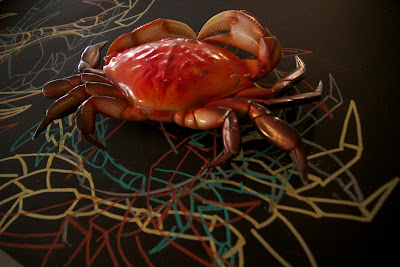This photographic screensaver above speaks volumes. Students
are engaged. In this frozen
moment, you can see the intensity in their eyes as they capture the model on
the pages or screens in front of them. This was a wonderful, productive month
of drawing with my Grade Eleven IB Visual Art classes. From contour drawing with wire, to
blind-drawing with iPads and conventional drawing tools, many students showed
tremendous growth in their capacity to see (and draw). Importantly, the students found joy in
the drawing process. Three
eighty-minute sessions with a live model were a highlight of the month.
The most rewarding outcome of the work was that some
students discovered their drawing ability. Some students, who previously feared drawing or felt they were inadequate
drawers, discovered a strength within themselves.
Each student produced a body of work that was unique to him/her. “There is no one right way to
draw,” says the teacher. Sometimes students actually start to believe this and see their
own individual strengths and stop comparing themselves to others. The comparison of drawing skills often starts
in the early grades at school and it can really crush students’ confidence when
some students get accolades and get pegged as “the good drawers” by peers and
teachers. It is not too late to undo the preconceptions and through a series of exercises and a less precious approach to mark-making, students can loosen up and start to enjoy the drawing process and appreciate their own work.
At the end of the month-of-drawing, students were asked to select their strongest works to share with classmates for the final critique. Some students chose drawings they completed on iPads while others chose pieces they had created on paper with pastel or ink. One student chose a drawing that she had created on her laptop with a tablet. This student was very comfortable with the tablet and stylus tools but this particular drawing marked a turning point for her as it was done in a totally different style than the other work that she had done previously with these digital tools, which were slick and stylistic. For the first time, she was loosely sketching and experimenting with blind drawing with the tablet. It was wonderful that she recognised this herself and that she now knows she can break out of the stylistic way of drawing with her tablet if she wishes. This student also discovered that the tablet can be a perfect way to blind draw because one can draw on the tablet and turn the laptop screen off and therefore the drawing is completely invisible. Eureka = digital blind drawing!
I love when students recognize their strengths and their
challenges in their final reflections. I watched students struggle with quick contour drawings and
blind-drawings because they lacked total control of the process. It is wonderful when students own this
and say that it is an area that they know they need to work on.
Earlier this year, I got to be the drawing student and
experience the magic of blind-drawing all over again. While attending the SCAD
Art Educators Forum in Savannah, Georgia this summer, I took a Blind Drawing Course taught by Dick Bjornseth.
It was a wonderful little class with just a few students. Bjornseth brought some amazing art objects for us to draw, including his collection of bizarre plastic dolls and toys. These are a few of the blind drawings that I produced over the week-long class. I loved every minute of the course, from Bjornseth’s fantastic stories from a life-time of art-making to the hours spent, intensely blind-drawing. Blind drawing is something that I have been doing for decades but I never get tired of the process. Taking this course reminded me how much I love it and showed me another teachers approach to blind drawing.

It was a wonderful little class with just a few students. Bjornseth brought some amazing art objects for us to draw, including his collection of bizarre plastic dolls and toys. These are a few of the blind drawings that I produced over the week-long class. I loved every minute of the course, from Bjornseth’s fantastic stories from a life-time of art-making to the hours spent, intensely blind-drawing. Blind drawing is something that I have been doing for decades but I never get tired of the process. Taking this course reminded me how much I love it and showed me another teachers approach to blind drawing.











Hi Daun! Your post got me thinking about some cross-disciplinary opportunities between art and biology. Being able to draw is a skill that biology students need for both SL and HL courses. They are required to draw diagrams in every unit from cells to the human body. It would be interesting to come up with a way to help students link art and biology and make connections between the two subjects. Just something to consider for the future.
ReplyDeleteInteresting. Successful drawing really starts with looking closely at the subject in front of you. Blind drawing supports this looking. One needs to look intensely at the subject to draw blindly. I took Biology in high school because I liked the drawing aspect. I was not a fan of dissection and in "those days" we worked with lab partners...I would be the partner who would draw and anyone I was working with did the dissections. (I was a reactionary vegetarian...didn't want to dissect anything but always loved to draw.) I like the idea of making connections between Science & Art. Observation in both subjects is a vital aspect.
ReplyDelete